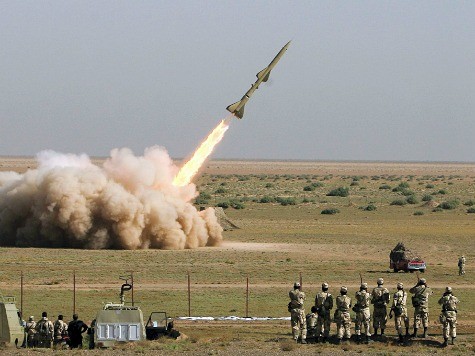While the West curried favor with Iran by indulging them in their pursuit of nuclear weapon with the new agreement signed over the weekend, Iran sent missile technicians to North Korea to join in development of a new rocket booster for long-range missiles or space launchers.
The Shahid Hemmat Industrial Group (SHIG), Iran’s group that is in charge of building Iran’s liquid-fueled missiles, sent technicians to Pyongyang through late October, to help build a new, 80-ton rocket booster, which could a long-range missile or space launch vehicle which could load nuclear warheads. The booster could be moved to Iran.
Recent U.S. intelligence assessments state that within two years, North Korea and Iran will have missiles capable of hitting the United States. The booster was described by one official as a thruster for a “super ICBM” or a heavy-lift space launcher. He added, “It is completely new from what they have done so far.” He asserted that the information was buried by the Obama Administration so they could finish the agreement in Geneva with the Iranians, saying, “Why does the administration want so much to negotiate a nuclear agreement with Iran if they know full well that that country is building nuclear delivery vehicles?”
Satellite imagery disclosed North Korea is building a larger missile or space launcher than it has ever had before.
But don’t worry, the State Department’s special envoy for North Korean nuclear affairs Glyn Davies had quite a threat for North Korea if they won’t give up their nuclear weapons: “If we do not see signs of North Korean sincerity, if they do not act, demonstrate that they understand they must fulfill their obligations, give up their nuclear weapons, then there’s more pressure that will be brought to bear on them.”
Yeah, that Obama pressure has worked wonders so far.
In September 2012, Kim Yong Nam, a senior North Korean official, visited Tehran, and agreed with Iran’s supreme leader Sayed Ali Khameni that the United States was their common enemy.
SHIG, which has built all of Iran’s liquid-fueled missiles, was sanctioned by the United Nations in 2006 for illicit missile transfers. In July, 2013, the National Air and Space Intelligence Center released a report that stated, “Continued efforts to develop the TD-2 and the newly unveiled [mobile] ICBM show the determination of North Korea to achieve long-range ballistic missile and space launch capabilities … Iran will likely continue to pursue longer range ballistic missiles and more capable [space-launch vehicle], which could lead to the development of an ICBM system … Iran could develop and test an ICBM capable of reaching the United States by 2015.”
Even the comatose state Department revealed in a 2009 cable on Iran’s Ballistic Missile program that “Iran has the largest and most active missile program in the Middle East … Iran has accelerated its work toward developing a domestic space program.” The report continued that the Safir space launcher
has demonstrated several capabilities necessary for longer-range ballistic missiles: staging, clustered engines in the second stage (although these were small), and gimbaled engines for control of the second stage, a more advanced technique than the jet vanes used in the first stage. Iran currently appears focused on increasing the capability and range of its ballistic missiles. Although Iran is unlikely to deploy the Safir SLV as a ballistic missile, the Safir, and the development and test of the two-stage Sajjil [medium-range ballistic missile], has provided Iran with much of the technology and experience necessary to develop and produce longer-range ballistic missiles, including ICBMs. Tehran could attempt to develop and test much of this technology under the guise of an SLV program.

COMMENTS
Please let us know if you're having issues with commenting.